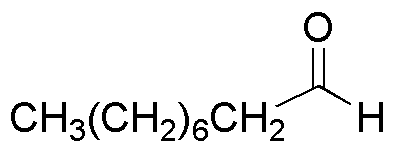Nonanal is widely utilized in research focused on:
- Fragrance Industry: Nonanal is a key ingredient in perfumes and scented products, providing a fresh, citrus-like aroma that enhances the overall fragrance profile.
- Flavoring Agent: In the food industry, it is used as a flavoring agent, particularly in products that aim to replicate citrus flavors, offering a natural alternative to synthetic flavorings.
- Cosmetics: Nonanal is incorporated into cosmetic formulations for its pleasant scent and potential skin-conditioning properties, making it a popular choice in creams and lotions.
- Biochemical Research: Researchers utilize nonanal in studies related to lipid metabolism and cellular signaling, providing insights into various biological processes.
- Insect Repellents: Due to its insect-repelling properties, nonanal is used in the formulation of natural insect repellents, offering an eco-friendly alternative to synthetic chemicals.
General Information
Properties
Safety and Regulations
Applications
Nonanal is widely utilized in research focused on:
- Fragrance Industry: Nonanal is a key ingredient in perfumes and scented products, providing a fresh, citrus-like aroma that enhances the overall fragrance profile.
- Flavoring Agent: In the food industry, it is used as a flavoring agent, particularly in products that aim to replicate citrus flavors, offering a natural alternative to synthetic flavorings.
- Cosmetics: Nonanal is incorporated into cosmetic formulations for its pleasant scent and potential skin-conditioning properties, making it a popular choice in creams and lotions.
- Biochemical Research: Researchers utilize nonanal in studies related to lipid metabolism and cellular signaling, providing insights into various biological processes.
- Insect Repellents: Due to its insect-repelling properties, nonanal is used in the formulation of natural insect repellents, offering an eco-friendly alternative to synthetic chemicals.
Documents
Safety Data Sheets (SDS)
The SDS provides comprehensive safety information on handling, storage, and disposal of the product.
Product Specification (PS)
The PS provides a comprehensive breakdown of the product’s properties, including chemical composition, physical state, purity, and storage requirements. It also details acceptable quality ranges and the product's intended applications.
Certificates of Analysis (COA)
Search for Certificates of Analysis (COA) by entering the products Lot Number. Lot and Batch Numbers can be found on a product’s label following the words ‘Lot’ or ‘Batch’.
*Catalog Number
*Lot Number
Certificates Of Origin (COO)
This COO confirms the country where the product was manufactured, and also details the materials and components used in it and whether it is derived from natural, synthetic, or other specific sources. This certificate may be required for customs, trade, and regulatory compliance.
*Catalog Number
*Lot Number
Safety Data Sheets (SDS)
The SDS provides comprehensive safety information on handling, storage, and disposal of the product.
DownloadProduct Specification (PS)
The PS provides a comprehensive breakdown of the product’s properties, including chemical composition, physical state, purity, and storage requirements. It also details acceptable quality ranges and the product's intended applications.
DownloadCertificates of Analysis (COA)
Search for Certificates of Analysis (COA) by entering the products Lot Number. Lot and Batch Numbers can be found on a product’s label following the words ‘Lot’ or ‘Batch’.
*Catalog Number
*Lot Number
Certificates Of Origin (COO)
This COO confirms the country where the product was manufactured, and also details the materials and components used in it and whether it is derived from natural, synthetic, or other specific sources. This certificate may be required for customs, trade, and regulatory compliance.

